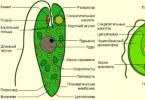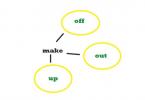Removing and installing (replacing) the clutch
The main malfunctions that require removal and disassembly of the clutch to eliminate are:
Increased (compared to usual) noise when the clutch is engaged;
Jerks when the clutch operates;
Incomplete engagement of the clutch (the clutch “slips”);
Incomplete disengagement of the clutch (the clutch “drives”).
HELPFUL ADVICE
If the clutch fails, we recommend replacing all its elements at the same time (driven and pressure disks, clutch release bearing); The work of replacing a clutch is labor-intensive, and undamaged clutch elements have already had a reduced service life, so if they are installed again, the clutch may need to be replaced again after a relatively short mileage.
You will need: a “12” wrench (a socket head is more convenient), a mounting blade, a mandrel for centering the driven disk.
1. Remove the gearbox
2. If you are installing the old pressure plate, mark in any way (for example, paint) the relative position of the disc housing and the flywheel in order to install the pressure plate in its original position (to maintain balance).
3. While holding the flywheel with a mounting spudger (or a large screwdriver) from turning, remove the six bolts securing the clutch pressure plate housing to the flywheel (for clarity, the photo was taken on removed engine). Loosen the tightening of the bolts evenly: each bolt two turns of the wrench, moving from bolt to bolt along the diameter
NOTE

In a vehicle equipped gasoline engine, the clutch pressure plate is attached to the flywheel with six bolts, and on a car with diesel engine- nine bolts.

4. Remove the clutch pressure and driven discs from the flywheel, holding the driven disc.
5. Inspect the clutch driven disc. Cracks on the parts of the driven disk are not allowed.

6. Check the degree of wear of the friction linings.

7. If the rivet heads are recessed by less than 0.3 mm, the surface of the friction linings is oily or the rivet joints are loose, then the driven disk must be replaced.
If the driven disk linings are oily, the cause may be oil seal wear. input shaft gearboxes It may need to be replaced.

8. Check the reliability of the damper springs in the hub sockets driven disk, trying to move them in the hub sockets by hand. If the springs move easily in their seats or are broken, replace the disk.

9. Check the runout of the driven disk, if visual inspection its warping was detected. If the runout is greater than 0.5 mm, replace the disc.

10. Inspect the flywheel friction surfaces...

11. ...and the pressure plate, paying attention to the absence of deep marks, burrs, nicks, obvious signs of wear and overheating, Replace the defective components.
12. If the rivet connections of the casing parts and the pressure plate become loose, replace the pressure plate assembly.

13. Using an external inspection, evaluate the condition of the pressure plate spring diaphragm. Cracks on the diaphragm spring are not allowed. Places And the contact of the spring petals with the clutch release bearing must be in the same plane and have no obvious signs of wear (wear should not be more than 0.8 mm). Otherwise, replace the pressure plate assembly.

14. Inspect the connecting links of the casing and disk. If the links are deformed or broken, replace the pressure plate assembly.


16. ...and inside springs. The rings should not have cracks or signs of wear. Otherwise, replace the pressure plate assembly.
17. Before installing the clutch, check that the driven disk moves easily along the splines of the transmission input shaft. If necessary, eliminate the causes of jamming or replace defective parts.

18 Apply refractory grease to the hub splines of the driven disc.
19. When installing the clutch, first, using a mandrel, install the driven disk, and then the pressure plate housing, aligning the marks made before removal, and screw in the bolts securing the housing to the flywheel,
NOTE
Install the driven disc so that the protruding part of the disc hub is directed towards the clutch housing diaphragm spring.

20. Screw in the bolts evenly, but one turn of the key each, one at a time, as shown in the photo.
21. Remove the mandrel and install the gearbox.
22. Check clutch operation
Replacing the clutch on a Kia Sid takes from 3 to 8 hours. Replacing the Kia Ceed clutch is done only with the removal/installation of the gearbox. On some models, to remove the box you need to remove the subframe. It is best to determine what exactly to change: the disk, basket or release bearing after the box is removed.
The decision to replace the clutch on a Kia Ceed must be made after diagnostics at a car service center. Some symptoms may be similar to a faulty transmission or gearshift mechanism. On robotic boxes(robot, easytronic, etc.), after replacing the clutch you will need to adapt the grip point. This can be done at our stations.
Cost of replacing a clutch on a Kia Sid:
If you notice that the clutch begins to behave differently than before, we recommend that you immediately contact a car service for diagnostics. If you start this moment, then subsequently, in addition to replacing the clutch on the Kia Sid, you will also have to replace the flywheel. And the cost of a flywheel is several times higher than the cost of a clutch kit.
When replacing the clutch, we also recommend replacing the crankshaft rear oil seal and replacing the axle shaft seals. When replacing a clutch, a good mechanic will always pay attention to the condition of the gear selector rod seal. The cost of seals is minimal and it is better to do everything at once without overpaying for the same work in the future.
Replacement cost Kia clutch The seed depends on the need to remove the subframe and remove the box. It happens that people try to replace the clutch on their own, they fail and they bring a half-disassembled car to us.
The main signs of a faulty clutch:
- increased noise when engaging and disengaging the clutch;
- incomplete engagement of the clutch (the clutch “slips”);
- incomplete disengagement of the clutch (the clutch “drives”);
- jerking when the clutch operates.
Clutch replacement warranty- 180 days.
The most good kits clutch release : LUK, SACHS, AISIN, VALEO.
Diagnostics of the clutch when replacing it at our service station is free!
Kia Ceed SW FL 2010 1.6 5MT
2.5 years, mileage 30 thousand km.
It happened interestingly on a recent Sunday (15.07). Kazan highway, Vetchakovskaya mountain, road from the garden. Standard plug. Purely Russian, idiotic. When a truck at a speed of 7 km/h overtakes another truck traveling at a speed of 5 km/h.
Warm, +29. There are five people in the car. Traffic jam, bad. Many overtake on the side of the road. First, gas, one and a half meters, brake. And at this pace for about 30 minutes. At a speed of 0.5 km/hour. Already on the mountain, the road became clearer, second, third and... we’re not going! The engine roared, the revolutions jumped to 4000 thousand, but... there was no acceleration! Okay, I let off the gas, into second, slowly. Another try - and again the same thing!
A minute later it was restored, of course, but - a most unpleasant phenomenon, however. The clutch is slipping.
I didn’t want to believe it and further along the highway I checked everything. Nah, everything's fine. The clutch is cool and working. However, an unpleasant aftertaste remained.
There was no noise, no smell, nothing suspicious or special. Just a slipping of the overheated clutch.
 From 9 pm to 3 am I read anything and everything on the Internet about an overheated, burnt, scorched clutch.
From 9 pm to 3 am I read anything and everything on the Internet about an overheated, burnt, scorched clutch.
General summary - khan clutch. First call. After this it usually starts to burn. More often - within a month. We need to change it.
The next day after work I tried to check the car again. On the mountain. Speed 50 km/h. In third gear. Pedal to the floor. No effect. I mean, you can't check. Everything works fine. And 5-6 thousand revolutions - how to get them? The computer doesn’t! That is, the pedal to the floor is a task for the car to increase speed. After three or four seconds, the revolutions begin to increase little by little, the acceleration of the car is adequate - acceleration slowly begins. There is no slipping.
I went to my brother's auto mechanic.
How, what, why?
Yes, how and why... The car is like that. And the driving style has nothing to do with it (they recommend this on the internet - don’t keep your foot on the clutch - in fact, this is complete nonsense and crap. I’d really like to look at this asshole, who writes this and (probably) drives. Most likely, this is a purely theoretical asshole, who has never traveled in Russia. So, he sucked something out of his finger).
Because there's a traffic jam. Up a long mountain. 3-4 real lanes instead of two - they drive along the side of the road, others overtake them, along the same side. And the main lanes are busy. Because the trucks are “chasing” in a race.
And try not to drive close to the one in front - the “muzzle” of the “happy” one, that is, the impudent one, immediately gets in. AND average speed- 1-2 km. You can't go at that speed on the first one - it's too slow. That's why you work the clutch constantly - first, sometimes second, brake, first - too quickly - you release the clutch - and so on - the whole mountain.
Brother's summary after examining and testing the clutch - it's time. The release lever has become too thin. And the clutch grabs too high (by pressing the pedal). No, you can drive, of course. And it's okay to drive. And to check whether the same clutch slippage can be achieved is possible only in the same grueling half-hour traffic jam when driving uphill. The slipping will happen again, 100%, and the clutch may even start smoking. And when normal driving everything will be OK. That is, you can travel through autumn, winter, and even spring (under normal conditions).
 - so do we need to change it!?
- so do we need to change it!?
- take a look yourself. Was there a call?
- yes, I was
- well, what do you want?
Ahead is Sochi and the serpentine road with the Novo-Mikhailovsky Pass, where it’s impossible to get there without traffic jams. Therefore, the risk of standing somewhere there, at a 180-degree turn and immediately rising 30 degrees, is very high. And repairing a clutch in the south will not cost 10 thousand, that’s all.
I ordered a set - basket, cylinder, release lever in my native Foreign car. They offered either a “native” Kia-Sidov kit (4600 rubles) or a Valeo kit (3800 rubles). 6 hours of reading anything and everything on the internet gave me a lot of information. So I didn’t think for a long time - I ordered Valeo. Moreover, they can bring him by the end of the week (two or three days), but his relatives will have to wait two or three weeks.
Besides -
Native Kia clutch Ceed doesn't walk for a long time. And at 4-8 thousand, many burned it. And 30-40 thousand is almost 100% replacement clutch. [On some cars (maybe 2005-2007), the clutch runs up to 100 thousand without problems].
It’s still fresh in my memory, where the “pupils of Fursenko and the Unified State Examination” tore off 6 thousand rubles and did nothing - they didn’t tighten the handbrake (I asked to see), they didn’t replace the stabilizer struts (they’re already knocking), they slipped 90-ruble candles for 400 rubles, on which I couldn’t even leave the service (!), they screwed in my old ones.
I ordered a complete clutch kit on Monday. The basket with the disc arrived quickly, but the releaser had to wait a whole week. The next week, on Wednesday, I gave the car to my brother. Fortunately, the week of waiting for the release smoothly turned to Monday, Tuesday, then the store simply swore that it would be on Wednesday.
Everything was delivered on Wednesday. My brother dismantled the car (oh, the horror! The wheels were removed, the axles were removed, the engine was partially weakened and raised - a lot of things had to be removed and unscrewed - it’s scary to look at). My brother went to get the clutch himself, started installing it, and... it doesn’t fit! Yes, a completely new clutch, Valeo, for new Kia cars Ceed SW FL 2010, specifically for the WIN code printed on Windshield- NOT SUITABLE! The shape of the basket's petals is different - wider and the petals are larger. And the larger basket itself simply won’t fit. And it doesn’t fit on the axle.
The situation is don't believe your eyes. Call me, call Inomarka - what kind of crap they brought! Those who ordered using the WIN code were delivered! We went to Inomarka, checked it ourselves, checked it, rechecked it - everything is correct - my car should have the clutch that they brought. But it doesn't fit!
 It seems that the first batch of FL 2010 cars was made with a shitty clutch, it’s not for nothing that many Kia-Sid forums call the clutch Kia Ceed the weak place. And many people burn it at 4-8 thousand km. The Koreans should have apologized to their customers and corrected their mistake, but... they acted differently. They just quietly quickly changed the clutch to a more efficient one, and new cars (with the same WIN code!!!) began to be produced with a new clutch, completely unsuitable for the first n-thousandth batch of FL 2010 cars. What a simply fucking act!
It seems that the first batch of FL 2010 cars was made with a shitty clutch, it’s not for nothing that many Kia-Sid forums call the clutch Kia Ceed the weak place. And many people burn it at 4-8 thousand km. The Koreans should have apologized to their customers and corrected their mistake, but... they acted differently. They just quietly quickly changed the clutch to a more efficient one, and new cars (with the same WIN code!!!) began to be produced with a new clutch, completely unsuitable for the first n-thousandth batch of FL 2010 cars. What a simply fucking act!
So what should I do? We started calling all the stores and warehouses. Why call? What to ask? We need a clutch for such and such WIN, but not for this, but... for this, just another... Some kind of bullshit.
They took their loved ones with them removed clutch and they were just going to go to the warehouses in Nizhny Novgorod, look for the same thing - how could it be otherwise? Then we got a little lucky. Someone also ordered a clutch kit for the Kia Ceed FL 2010 from the same foreign car, only a “native” one, some Hyunday/Kia. Compare - it is! They took him.
Later, the store itself figured out the situation and found it somewhere in Moscow the right clutch(with the same dimensions), only normal, walking standard 150 thousand, but we had to wait another week for it.
 There was absolutely no time - tomorrow we were going to the south, and therefore we took what turned up - a small and shitty “native” clutch. According to my brother, the design is complete crap. And this new clutch will be enough for 20 thousand, no more. Because the design of the “native” clutch is fundamentally wrong. And the petals are small, and the pressure is not that great. Korea, in short. [Korea] is already like the dirtiest dirty word.
There was absolutely no time - tomorrow we were going to the south, and therefore we took what turned up - a small and shitty “native” clutch. According to my brother, the design is complete crap. And this new clutch will be enough for 20 thousand, no more. Because the design of the “native” clutch is fundamentally wrong. And the petals are small, and the pressure is not that great. Korea, in short. [Korea] is already like the dirtiest dirty word.
He collected everything on Thursday, around lunchtime. And literally an hour later I went south.
I didn’t feel any super sensations. Same clutch as before. And it grabs completely somewhere in the upper half. And upon arrival from the south, the clutch became exactly the same as it was - it grabs at the top, as it was for the first two and a half years.
The disappointment was simply wild. Another major confirmation that the Kia Ceed SW FL 1.6 MT is an extremely “raw” and frankly weak car. NOT-thought-out. It looks beautiful, it seems to have all the bells and whistles, and the price is appropriate - mine specifically cost me 750 thousand rubles. But in fact - some kind of rawhide crap. No, the 2013 models will PROBABLY be better, since with the same configuration they now cost exactly a million rubles (950-970 rubles), but it’s hard to believe. Specifically the clutch - yes, quietly replaced with a better one, it will [probably] work fine. Only everything else... one hundred percent is the same raw meat.
This is the story with the clutch for the Kia Ceed SW FL 2010.
I paid 4000 rubles for the work. Specifically, only the basket and release lever were replaced - they cost 2,498 rubles. That is, all work costs 6,498 rubles. And in a year you will have to pay one and a half times more, because this “new” clutch will not be enough for a long time and you will have to buy and install a more advanced and working clutch.
 I was a little surprised by the design release bearing. This is 122 horses transmitted to move a one and a half ton car through such a thin 8 mm rim!
I was a little surprised by the design release bearing. This is 122 horses transmitted to move a one and a half ton car through such a thin 8 mm rim!
No, for Korea, where there are no traffic jams, no off-road conditions, no garages somewhere in a field or dachas with impassable roads and no slipping, this is probably enough. However, this is absolutely not suitable for rashi!
I immediately remembered. On which I didn’t skid anywhere. And in 10 years of operation, almost everything has been broken, replaced, or repaired. And even after 8 years of operation. But not the clutch!
In general, of course, the Kia Ceed was a complete disappointment. 2.5 years old car TOTAL! And such problems!
She's no good kia ceed this one works. And absolutely not for Russian conditions operation. Weak body, weak parts, no electronics. Although, maybe it was specially configured that way. Because try to remove these brakes in the car control program and give the car all its 122 horses - but in six months it will fall apart!
I guess the most strong cars- these are Americans (probably). AND soviet cars(just not the Russians! - God forbid). Then, probably, the Germans. And somewhere in the hundredth place are the Koreans.
This is how the situation turns out.



